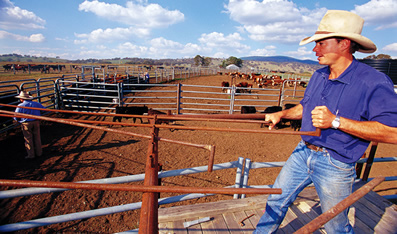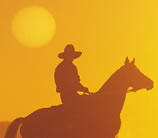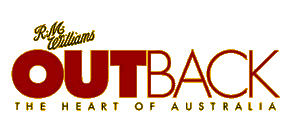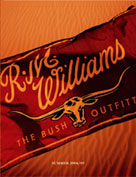OUTBACK STATIONS
Where holistic is king

Story Peter Austin
Photos Darren Clark
Sitting alongside George King as he eases his Cessna 182 into a low swoop
over the upland pastures of Coombing Park, one can't help but share
his sense of excitement at the changes he has wrought there in just five
tumultuous years. The famous 3000-hectare grazing property near Carcoar
in the NSW central tablelands has undergone a wholesale change in direction
at the hands of its lateral-thinking young manager and co-principal.
The shake-up has redefined the property's enterprise mix, but more fundamentally has profoundly altered the way things are done, and decisions taken. In production terms, woolgrowing has been dumped as the dominant activity in favour of a single focus on beef cattle breeding, and new grazing systems introduced in a bid to reverse years of productivity decline and to cut input costs. At the same time, Coombing Park has become a high-profile 'test site' for holistic management principles espoused by former Rhodesian rangeland expert and latterly United States-based author and teacher Allan Savory. And new ventures are being explored, including wind power generation, with one Spanish company already showing interest in establishing a wind farm on a suitable ridge of exposed high country. Most important, the property is still operating under the ownership of the Whitney Pastoral Company in which the King family has a controlling stake - not under a receiver-manager for a bank, as seemed perilously close a few years ago.
Flying low over the cattle yards, built to a design George adapted from one he saw and liked while working in the Kimberley, cows and calves are being yarded for trucking to a store sale in Dubbo - a tactical move to ease grazing pressure on pastures that are the priority concern at Coombing Park. Under the holistic principles employed by George, supplementary feeding has no more place in the management handbook than overstocking. Instead, stock numbers are constantly adjusted - and mobs manoeuvred - to match available feed.
Another pass in the aircraft reveals the majestic Coombing Park homestead, built in 1900 for George's great-great grandmother and, since 2001, converted to an owner-occupied guesthouse that has given the long-neglected home a new lease of life. George, who is still a youthful (and single) 29, took over in 1997 as managing director of Whitney Pastoral Company Pty Ltd, the family entity that has held this historic property since the company was formed in 1907. His accession to the top job followed the 1996 return of the King family - George, his sisters Katie and Shish, and their parents, Berkeley and Penny - to the property they left in 1978 after a difficult period in which Berkeley and his late father, Ewart, shared the running of the property.
"I was theoretically the manager, but I was never given any real authority and things went on much as they always had, with my father holding the reins," recalls Berkeley, now philosophical rather than bitter about that unhappy 12 years of his life. Problems of succession and family company control have been a recurring theme in Coombing Park's history (like so many stations), but so far, at least, the property has survived intact to tell the tale.
This is what makes Coombing Park's story remarkable - probably
unique: the fact that in nearly 180 years of documented European occupation,
it has been owned (give or take a few more legal entities) by just two families.
And unlike most stations of its size in which ownership changes or even
generational successions have been accompanied by clean-ups and either a
destruction or a scattering of written records, at Coombing Park it's
all still there - from day one.
A tour of the property reveals ample evidence of its rich history -
involving convicts and bushrangers, Cobb and Co associations, famous bloodstock,
mining booms, illustrious visitors and family upheavals. Coombing Park is
also an interesting study of land ownership, as successive generations of
one family have coped with inheritance battles, closer settlement and debt
crises that have claimed so many other famous properties.
It was a prominent Sydney merchant by name of Thomas Icely who in 1826 first took up a 560-acre grant of land on the site of the present property that he named Coombing Park. Icely, who was a foundation member of the first NSW Legislative Council, was quick to recognise the value of the land for grazing and lost no time in expanding the run and stocking it with the new Merino sheep from the foundation flock of John Macarthur.
Strategically located not far from Bathurst, the first settlement west of the Blue Mountains, yet on richer, well-grassed and reliably watered tablelands country, Coombing Park was - then as now - a 'dress circle' grazing run. Although the area of the property at the time that Icely's son (also Thomas) sold it in 1881 was given on the title as 13,000 acres, early records have the run extending at one stage to nearly 130,000 acres (52,000 hectares) and incorporating country later hived off as separate station properties, Waugoola and Sunny Ridge.
The contraction of the property to its present size, still substantial, by district standards, resulted from the enforced sale of half the total area for closer settlement after the World War 11. Despite the frequent assertions of present-day "greens" that the country was timbered at the time of European settlement, explorers' records and contemporary accounts suggest otherwise. It is more likely the country was open grassland dotted with the box, apple and stringybark that still characterise the region today. The soil is mainly red basalt and the terrain gently undulating, except for alluvial flats that flank Coombing Creek - one of the headwater streams of the Lachlan catchment - which runs through the property on its way to joining the Belubula River.
Ranging in altitude from 700 to 1000 metres and receiving an average 750mm
of rainfall (some as snow), Coombing Park is one of the last of the true
station properties still surviving in an area now largely broken up into
intensively-run smaller blocks. A feature of the property immediately apparent
to any visitor today is the remarkably sound state of the original buildings
dating back to the Icely era, when up to 60 convicts were assigned to the
station. Foremost among these is the heritage-listed coach house and stables
complex, built in stages by convict labour from the 1820s and completed
by 1838 using locally quarried stone and bricks made on the property. ![]()
Full story: OUTBACK, Aug/Sept 2003


